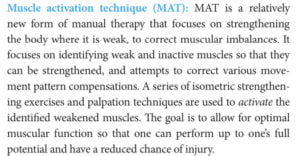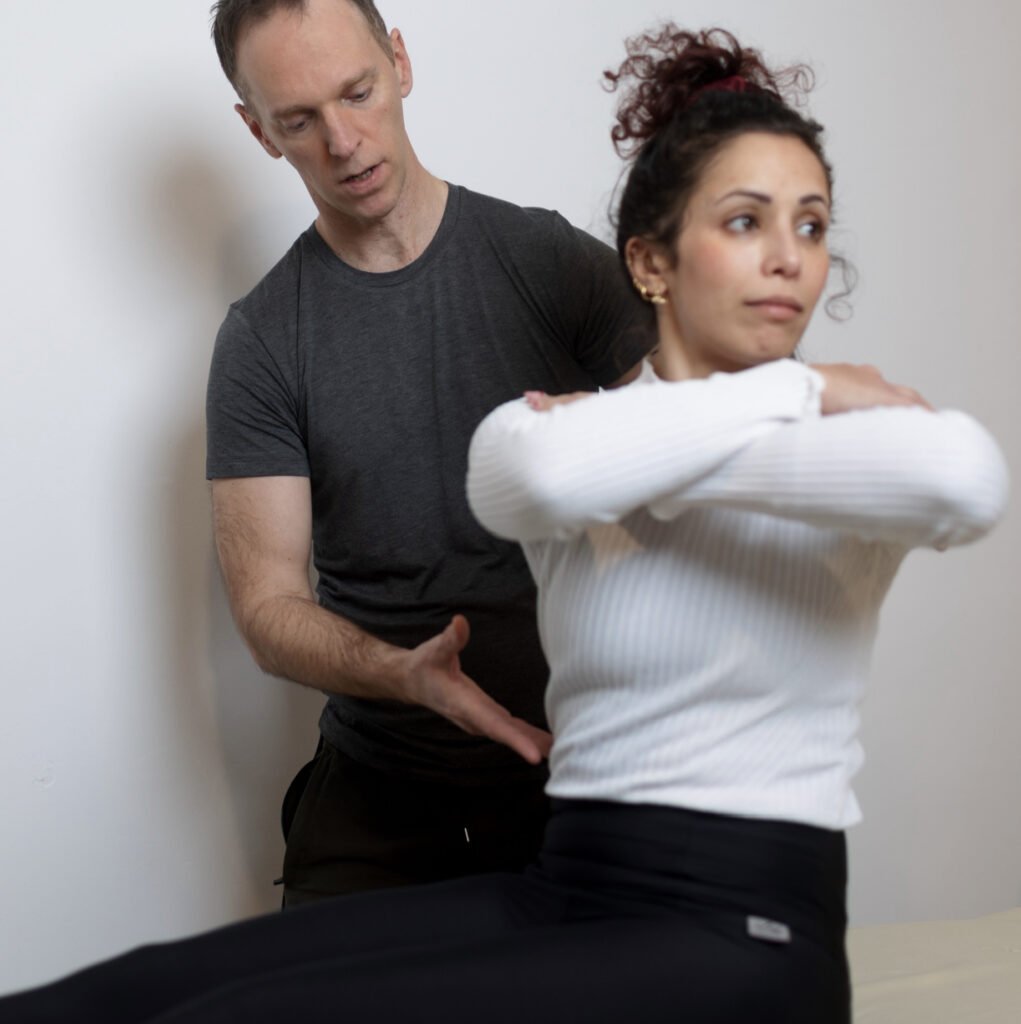Muscle Activation Techniques is method for reactivating muscles that are not functioning properly. MAT has been embraced by major professional athletes, and it also proves very useful in rehab and injury prevention.
In this post, you’ll learn what MAT is, why it might be helpful for Pilates teachers (and other modalities too).


What is Muscle Activation Techniques (MAT)?
Muscle Activation Techniques, or MAT as it is commonly called, is a method of:
- Identifying limitations in range of motion (ROM)
- Testing muscles responsible for that active range of motion
- Improving neuromuscular communication
MAT is a non-medical modality that focuses on the neuromuscular system. In short, it aims to assess and improve the communication between the brain and muscles.
MAT was devised by Greg Roskopf.
History of Muscle Activation Techniques
MAT is not the only muscle testing and activation program out there, and it’s definitely not the first. But Greg Roskopf made some unique innovations to muscle testing and activation to make Muscle Activation Techniques a unique modality. https://muscleactivation.com/our-timeline/
While a trainer for the Utah Jazz, Roskopf learned about muscle testing from Dr. Craig Buhler, who was the Jazz’s chiropractor. Dr. Buhler had learned about the practice from Dr. Alan Beardall (who founded Clinical Kinesiology).
Roskopf went on to found Muscle Activation Techniques. He made important developments (including more muscle tests) and changes (such as testing muscles in a more shortened position).
Kendall and Kendall: the Kendall’s publication contained many muscle strength and flexibility tests which are still used today. However there is not much in the book in terms of strengthening, much less activation.
George Goodheart developed an approach to muscle activation he called Applied Kinesiology.
Support book stores! Buy from bookshop.org.
How Does MAT Work?
MAT uses manual muscle testing to discover poor neuromuscular communication. It then improves the connection between the nervous system and the muscles by 1) manual palpation (called a Digital Force Application to Muscle Attachment Tissues (DFAMAT)) or 2) specific isometric tests (called a Positional Isoangular Contraction (PIC)).
To learn more of the science behind Muscle Activation Techniques, read How Muscle Activation Techniques Works: the Science Behind MAT.
What is an MAT Session Like?
While sessions may vary somewhat from practitioner to practitioner, a typical session will run in a similar manner.
MAT practitioners generally work systematically. They perform an assessment to identify discrepancies in range of motion (ROM). A practitioner then chooses which ROM to focus on. They “clear” one ROM (by making it symmetrical to that of the opposite limb or body section), then proceed to the next.
At the RX level, the RX practitioner will likely follow a protocol design to enhance the entire neuromuscular network.
Does MAT Hurt?
There’s no easy answer to whether your MAT session will have moments that are painful. Muscle tissue that is inflamed can be sensitive to the touch, so sometime palpation can involve some pain. On the other hand, some palpation feels very good, even if the tissue is inflamed.
The good thing about MAT is that the practitioner does not need to palpate any area very long.
Do keep your practitioner informed about your pain level.
What is the Difference between MAT and other Muscle Testing and Muscle Energy Techniques?
Most muscle testing systems look to compare the strength of a muscle using a sustain test. Clients or patients are placed in a position that isolates or biases certain muscles, and then asked to withstand a force for a certain duration or until the force exceeds their ability to counter.
MAT aims increasing communication between the muscle and nervous system. This will make the muscle “stronger” by increasing the number of messages to contract that the muscle receives from the nervous system.
How I Discovered MAT
Many people first read about MAT from Timothy Ferriss’ best-seller, The 4-Hour Body: An Uncommon Guide to Rapid Fat-Loss, Incredible Sex, and Becoming Superhuman. But I first learned about MAT while reading Dr. Joe Muscolino’s Kinesiology: The Skeletal System and Muscle Function.
Healthy feet…great price!
- Fast shipping for $3-5
- Great variety
- Long-lasting quality
- Add lace-locks for quick changes

Try minimalist shoes from XeroShoes.com!
Why I Studied Muscle Activation Techniques
As a Pilates teacher, I found that sometimes I could cue and re-cue a client to use a certain group of muscles, but nothing I did would wake that muscle up and get it working. When I read Muscolino’s description of MAT as a modality that “focuses on identifying weak and inactive muscles so that they can be strengthened, and attempts to correct various movement pattern compensations (p. 725). I was excited to learn more about MAT, so I bought the Jumpstart book and starting reading about MAT and working through the exercises.


I saw a lot of success while working at the Specialist level, so I went on to Mastery certification.
Muscle Activation Techniques Certification
Muscle Activation Techniques certification happens in stages:
- Jumpstart program
- Specialist
- Mastery
- RX
We’ll look at the Jumpstart, Specialist, and Mastery programs in detail below.
Muscle Activation Techniques Jumpstart Certification
The first, introductory level of Muscle Activation Techniques certification is the Jumpstart program. Here, you’ll learn to:
- Assess and compare ranges of motion using the Comparative Assessment of Mobility (CAM)
- Perform muscle tests, called Active Muscle Contract & Sustain (AMC&S) tests
- Activate muscles using isometric exercises called PICs (Positional Iso-angular Contractions)
Jumpstart is a great intro to MAT. You can buy the book or sign up for the course with videos for just $99. While you’ll become more effective with the tools given through the later programs, you’ll definitely see some progress with clients using Jumpstart.
Healthy feet…great price!
- Fast shipping for $3-5
- Great variety
- Long-lasting quality
- Add lace-locks for quick changes

Try minimalist shoes from XeroShoes.com!
MAT Jumpstart Program Cost
You can take just one course ($99), or all three units at once ($299). All courses are completely online, including the content of the book, Jumpstart into MAT.
If you’d like to purchase a physical copy of Jumpstart book, that’s an additional $99.
To take a Specialist course, you must complete the relevant Jumpstart course first.
Muscle Activation Techniques Specialist Certification
With specialist certification, you learn specific muscle tests and treatment. There’s a lot of anatomy involved, but you can go at your own pace.
At the specialist level, you learn much more specific tests; not just for each muscle, but even divisions of that muscle. You’ll learn a lot of anatomy, but dividing it up course by course makes it more manageable.
Hint for learning all the anatomy and how to palpate like a pro, sign up for the Learn Muscles program (you can read our review here).
Muscle Activation Techniques Specialist Certification: Cost
You’ll need to complete the Jumpstart training ($99 each) for any division before your can start that course.
| Division | Course | Cost |
|---|---|---|
| Introduction | Free! | |
| Lower body | ||
| Hip | $995 | |
| Knee | $995 | |
| Foot | $995 | |
| Certification | $1,250 | |
| Upper body | ||
| Shoulder | $995 | |
| Elbow | $995 | |
| Wrist | $995 | |
| Certification | $1,250 | |
| Trunk & Spine | ||
| Trunk and Spine I | $995 | |
| Trunk and Spine II | $995 | |
| Neck | $995 | |
| Certification | $1,250 | |
| MAT Certification Total | $12,705 |
Muscles Activation Techniques Mastery: Cost
| Course | Cost |
|---|---|
| Lower Body | $995 |
| Upper Body | $995 |
| Foot Function | $995 |
| Wrist & Hand | $995 |
| Trunk & Spine | $995 |
| Cervical | $995 |
| Certification cost (x6) | $399 x2, $100 x 4 = $1,198 |
| Total | $7,168 |
Is MAT Good for Pilates and Yoga Teachers?
For various reasons, many Pilates teachers at some point start to look outside the Pilates method to increase their ability to help clients.
I use MAT daily as a Pilates teacher. While I don’t often sneak in a muscle test and palpation during a group class, I have used MAT to quickly relieve cramping. I also use the isolation exercises to help students activate muscles in a session.
But MAT gave my teaching an enormous boost because it gave me a good understanding of anatomy and biomechanics. If you want to level-up your anatomy and kinesiology, check out our Review of Muscolino’s Learn Muscles Anatomy Website.
Is MAT within your Scope of Practice?
Muscle activation involves 1) the manual testing of a muscle’s strength and reaction and 2) some intervention to strengthen the muscle’s responsiveness. That intervention may be a manual palpation of certain parts of the muscle or leading a client through a muscle isolation exercise.
Bibliography
Gin RH, Green BN. George Goodheart, Jr., D.C., and a history of applied kinesiology. J Manipulative Physiol Ther. 1997 Jun;20(5):331-7. PMID: 9200049. Link











